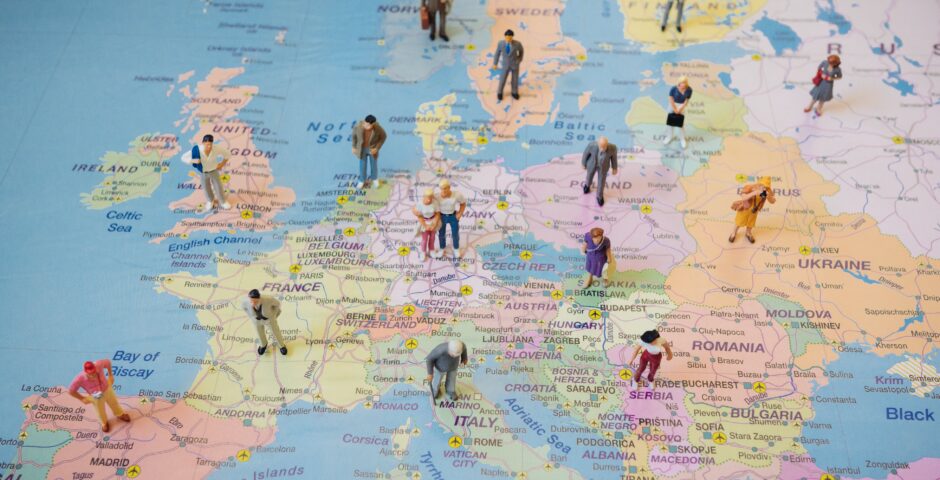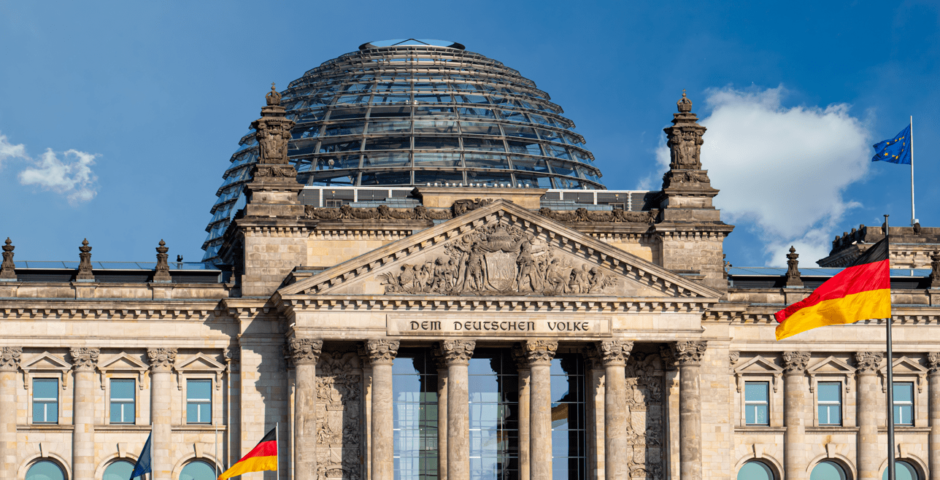Turnout in European elections

Improving or decreasing?
Without citizen participation, the democratic foundation of a government institution is weak, and this especially applies to parliaments. The importance of having a democratic foundation was also one of the main motivations behind the European Parliament elections that have been held since 1979 (while the Parliament is older, you can read more about it here). Still, turnout in European elections is relatively low. In the last European Parliament elections in 2019, the turnout rate was only 50.66%. This means that about half of the people who were allowed to vote within the entire Union actually did so. By comparison, during Germany’s federal elections in 2021, the turnout rate was 76.6%. The voter turnout was also higher during the Spanish elections earlier this year. 70.4% of eligible voters cast their ballots then.
The turnout rate can be linked to the legitimacy (or support within society) of a parliament. If less than half of the people showed up, it is more difficult to forcefully assert that a parliament acts on behalf of the people. Thus, low turnout may well be a threat to the democratic functioning of the EU. The following discusses turnout over the years, differences between member states, and other explanatory factors of low turnout. Finally, it looks ahead to the upcoming June elections.
During the first European Parliamentary election in 1979, 67.2% of eligible voters within member states cast their ballots. After these elections, we see a gradual decline in turnout through 2014. During the elections of 2014, we saw the lowest turnout, with only 42.6% of voters casting a ballot. Turnout increased again in the last election; in 2019, turnout was 50.7%. It is difficult to draw conclusions about the decline in voting without talking about the different countries within the European Union (EU) and the changing role of the European Parliament over the years.
Differences within the Union
The different member states of the EU also have large differences in turnout rates. Belgium had the highest turnout rate in 2019 at 88.47%. This can be explained by the fact that Belgium enforced voting. Belgians are obliged to go to a voting booth during the EP elections. They are not obliged to actually cast a vote, they may also cast a blank vote. Interestingly, Belgians are allowed to vote for the European Parliament from the age of 16, compared to 18 in the Netherlands and many other member states.
The high turnout in Belgium contrasts with the turnout in countries like Slovenia. There, the turnout rate in 2019 was only 22.74%. This is partly explained by the fact that turnout in Slovenia is also very low in national elections. This in turn has a lot to do with the country’s political history. In several young democracies within the EU, turnout is lower in both European and national elections. Especially in former communist countries, the history of autocracy can still have long-term effects. This is often attributed to a lack of democratic tradition. These countries have yet to get into the so-called “democratic routine”. This routine includes being used to participating in public debate and being accustomed to voting.
Specifically, strong intervention in market forces and restrictions on freedom of expression are still having an effect for a long time. Research from 2020 by Fuchs-Schündeln & Schündeln shows that there are still differences between Western European member states and Eastern European member states. Eastern European research participants indicated more often that democracy is not the best form of state government compared to their Western European counterparts. Interestingly, most new EU member states have a so-called “First Time Boost”. This means that they have a much higher turnout during their first EP elections compared to the following elections.
Yet trends can also be seen across all member states. In 1999, many countries experienced a lower turnout, including Greece and Denmark. In 2004, many countries experienced another small increase, then stagnated, dropping in 2014. Turnout rates for national elections are also steadily declining in many EU member states. However, we do see that the decline is faster within the EU. This is while the Eurobarometer shows that average satisfaction with the EU is rising.
Unknown makes unloved
Differences in national history are not an entire explanation for the lower turnout during EP elections. In fact, in almost every member state we see lower turnout during EP elections compared to national elections.
One of these reasons is that many people do not know how Europe affects their daily lives. There is a lot of ignorance about what exactly we are voting for, what the important decisions are, and what impact they will have on the individual. When this influence is not felt, people are less motivated to vote. Many people don’t deem the elections as important enough to vote. There is a certain apathy, a sense of powerlessness, toward the policies in Brussels. For many residents, it feels too far away from their daily lives.
This is also due to the fact that the topics surrounding the EU are sometimes very complex and technocratic. The EU websites, as well as many other EU media, contain a lot of jargon and complicated legislation. This is not an accessible way for most people to learn more about the EU, the EP elections, and their impact. For example, the EU has set up a special website to answer the question, “Why is voting important? The reasons given are very vague and obvious. Terms like “Laws have an impact on residents” do not give a concrete idea of the issues that will actually have an impact on the residents concerned.
In addition, there is very little media coverage of the European elections. The candidates, for example, are not very visible, even though there are certainly exceptional figures among them. Moreover, recent research by IPSOS I&O showed that 71% of Dutch people could not name a single European list leader.
Finally, the EU has so-called democratic deficits. In most democratic systems, you elect a parliament and a government. This can take place simultaneously in parliamentary democracies like the Netherlands, or at different times as in presidential systems in Cyprus, for example. While the European Parliament is elected, the European Commission is not elected by the people. It is elected by the governments of the 27 member states. In addition, Parliament did gain more power over the years. Parliamentarians are allowed to decide on more and more issues, yet they still do not have the right to initiate laws. Only the Commission has this right. These flaws in democracy may cause people to vote less.
Knowledge and voting behavior
At the individual level, several things influence whether or not a person will vote. For example, the more a person knows about the European Union, the higher the likelihood that person will vote. Especially when one knows that there will be policy proposals that have a lot of impact on a personal matter, one is more likely to vote. When climate, economic growth, and immigration play a role in the debate surrounding the election, more people go to vote.
Also, when people have more extreme perceptions about the EU, they are more likely to vote. This is true for Europhiles, but Euroscepticism ironically also draws many people to the polls. Employment rates also affect voting behavior. With higher unemployment rates, more people go to vote. In addition, older people are more likely to vote than younger people. Interestingly, obtaining or not obtaining EU subsidies does not influence the decision to vote or not.
National politics
The timing of national elections also plays a role. When national elections take place shortly before EP elections, turnout at the EP elections is often lower than when national elections follow EP elections. When EP elections take place after national elections, media coverage of EP elections often starts relatively late. We see this for example in the Netherlands where, for the time being, eyes are mainly focused on the government formation after the 2023 elections. It also has to do with the fact that many voters of the losing parties are disappointed and therefore less hopeful for the next elections at the European level.
When EP elections take place before national elections, turnout during the EP elections is generally higher. Politicians use the EP elections to get more attention in this case. It is therefore seen as a kind of pre-election or poll for the national elections. It becomes clear beforehand how votes are divided between the national parties and which issues the voter focuses on. The campaign for the national election then begins much earlier, so to speak.
Because of the great influence of national elections, EP elections have also been called “second-order elections”. That EP elections are second-order elections can also be seen in the fact that the debates are often about issues relevant at the national level. Identity politics and issue politics play an additional role here. In identity politics, reasoning is based on the needs of one specific group with a shared identity. With issue politics, a party or the debate is focused on one issue rather than a broader range of issues that will come up in the coming years. In the Netherlands, for example, this can be seen in the fact that debates often take place between the national list leaders, rather than between the candidates actually on the electoral list.
Short-term issues emerge in the campaign and have a major impact on voting behavior and the decision to vote at all. This makes European politics difficult to predict and dependent on issues in national politics. This is also due to the fact that most European political groups do not focus on an EU-wide campaign. National parties run the campaigns, so the connection to national politics is quickly made. Volt is an exception to this and in recent years we have seen more groups attempting this.
Discussions and Spitzenkandidaten
There has been more politicization of the EP in recent years. That means it is less technical, with more room for discussion. Within a politicized institution, decision-makers don’t just decide on technocratic solutions, but rather about political choices. However, a political choice also involves winners and losers. One can think of the Green Deal, which clearly has politically sensitive implications. For a long time, to the outside world, the EU was primarily a technocratic policy factory. It was unclear how decisions were made and what choices preceded them. This was also largely because many discussions took place behind closed doors.
This is slowly changing. By example with the Spitzenkandidat system. Through the Spitzenkandidaten procedure, the outcome of the elections is linked to who becomes the president of the European Commission. Each European group selects a Spitzenkandidat to run for the Commission presidency on their behalf. The candidate from the group with the most votes is nominated to become President of the European Commission. The level of political infighting has a lot of influence on the turnout rate. The greater the political discussions, the more people turn out to vote. At the same time, this politicization process is slow and the EU still has a technocratic image.
It is important to mention that politicization is not always a good thing. One of the reasons why the EU has relatively little politicization is because parties have historically collaborated better compared to the national context. Politicization can also be accompanied by far-reaching polarization. This can take place within parties, but also in the broader division between supporters and opponents of the EU. As a result, the EU can also be used as a scapegoat. The EU is then blamed for things, while sometimes the Union is not about it at all.
Even though there is still little coverage of European elections, especially compared to national elections, media attention has been growing in recent years. Media coverage is an important factor in increasing the turnout rate.
Propaganda and disinformation
What may be an important factor is propaganda and disinformation. The Kremlin is likely trying to influence these elections in several EU member states. It was recently discovered in the Czech Republic that several politicians are being funded by a disinformation campaign from Russia. Disinformation can contribute to apathy, which promotes the likelihood of not voting because it reduces trust in public institutions such as the EU. On the other hand, it can also actually promote voting. When more extreme parties are funded, they can expand their reach. As mentioned earlier, people are more likely to vote if they have more extreme views of the EU.
Possibilities to boost vote turnout
The EU can use a few tools to increase voter turnout. Accessible and understandable information about the EU is important in this regard. The EU itself must make improvements in the provision of information, but the media also plays a crucial role here. European issues, EP leaders, and political groups should also be better communicated to citizens. In addition, the EU can play a role by solving democratic deficits, such as complying with the Spitzenkandidat system and leaving more to Parliament. For the legitimacy of the EU the turnout rate must go up. The upcoming elections will show whether this happens.
Anoek has a Master’s degree in International Relations and a bachelor’s degree in political science. In this, she specialized in global political economy and the role of China. She currently works as a consultant in the public sector.
Image: Shutterstock




